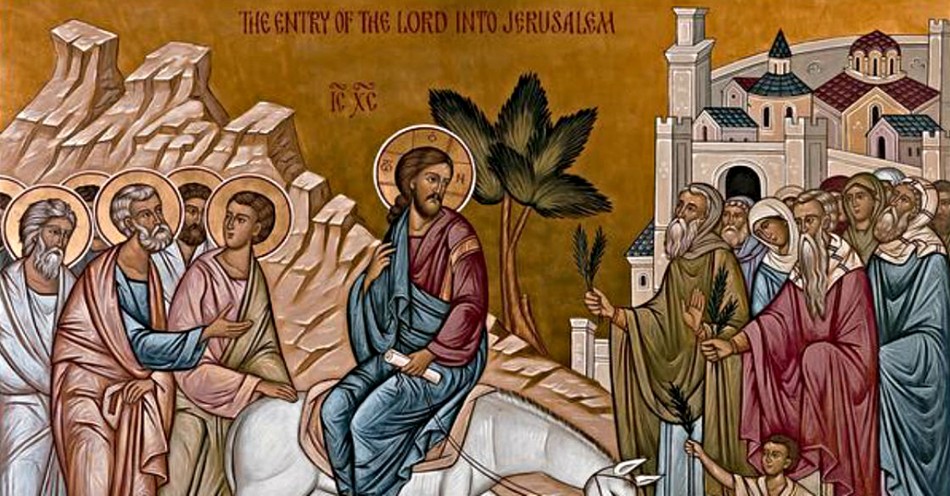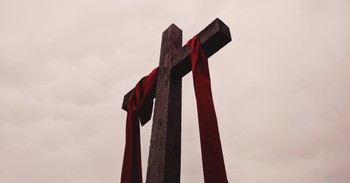A very large crowd spread their cloaks on the road, while others cut branches from the trees and spread them on the road. The crowds that went ahead of him and those that followed shouted, “Hosanna to the Son of David!” “Blessed is he who comes in the name of the Lord!” “Hosanna in the highest heaven!” When Jesus entered Jerusalem, the whole city was stirred and asked, “Who is this?” The crowds answered, “This is Jesus, the prophet from Nazareth in Galilee.” ~ Matthew 21:8-11
The Sunday before Jesus’s crucifixion, also known as Palm Sunday, is an important day for all Christians to study and remember. The Biblical account of Jesus’s triumphal entry into Jerusalem is so noteworthy that it’s one of the few events recorded in all four Gospels. When we piece together the details from each of Matthew, Mark, Luke, and John’s unique narratives—we gain a clear picture of who King Jesus is, why He came, and the future in store for all who put their hope and trust in Him.
What Was the Triumphal Entry?
When Jesus came to Jerusalem for the last time, He arrived to the adulation of many and the cheering approval of the crowd. The Triumphal Entry, as it is called, served a deeper purpose than simply a parade in His honor, however.
His coming in this manner had been revealed clearly in the Old Testament: the method, the timing, and the meaning. Zechariah 9:9 had told of the King's coming on the colt of a donkey so that Israel would recognize Him. From Daniel 9:25-26 the exact time of the Messiah's arrival can be calculated. Psalms 118:21-29 had announced the meaning of Christ's arrival, which the crowd realized in their shouts.
This event also fulfilled Jesus's promise. Several weeks earlier, some Pharisees came to lure Him back to Judea. Jesus said that He would not return until such time as the citizens of Jerusalem would say, "Blessed is He who comes in the name of the Lord" (Luke 13:31-35). Perhaps He intended this to further establish His credentials as the promised Messiah.
The Triumphal Entry accomplished two major goals. Because of the heightened excitement caused by the resurrection of Lazarus and then the public entrance into Jerusalem, He piqued the curiosity of the people there—important because of the many pilgrims who had come to the city for Passover. In addition, the approbation of the crowd protected Him, at least initially, from the murderous desires of the spiritual leaders in Jerusalem. The delay allowed the prophecies of the Old Testament to be fulfilled.
In a way, His entrance established a test for the people in Jerusalem. While many cheered His arrival, their faith would be challenged when He did not live up to the conquering Messiah of popular imagination. Instead, He effectively took over the Temple and called the people to the Kingdom of God. After several days, the shouts of praise turned into shouts for crucifixion.*
Why Were the Crowds Awaiting Jesus in Jerusalem?
Jesus ministered tirelessly in the days leading up to Palm Sunday. Among other righteous acts, our Lord healed the blind, cured ten lepers, ate dinner with that wee little tax collector named Zacchaeus, taught about the Good Shepherd, revealed to His disciples for the third time that He would soon be crucified. And in Bethany—a town about two miles east of Jerusalem, Jesus raised Lazarus from the dead. (John:11)
The large crowd that had gathered for Lazarus’s funeral and had witnessed their friend’s awe-inspiring resurrection could not keep quiet about the event. They returned to their homes and spread the word all over Bethany and the neighboring towns and villages until soon the reports of Jesus’s astonishing miracle had reached the ears of every person in the region. (John 12:12-19)
As thousands of people began to swarm to Jerusalem in preparation for the Passover, the story of Lazarus’s resurrection spread even further, and Jesus became a hot topic of conversation among the masses. They looked for Him all over Jerusalem and asked each other, “What do you think? Isn’t he coming to the festival at all?” But the chief priests and the Pharisees had given orders that anyone who found out where Jesus was should report it so that they might arrest him.” (John 11:56-57)
Jesus’s Kingly Preparation for the Triumphal Entry
Meanwhile, as Jesus and His disciples left Jericho and made their way to Jerusalem for the Passover, they traveled along the border between Samaria and Galilee, (Luke 17:11) The group stopped in Bethany, stayed for a couple of days, and dined with Lazarus, Mary, and Martha, who had prepared a dinner for them, in Jesus’s honor. (John 12:1-3)
During the dinner, Mary anointed Jesus’s feet with fragrant oil and wiped his feet with her hair. Judas Iscariot, the dishonest treasurer of the group and Christ’s future betrayer, was indignant that Mary had wasted the costly perfume when the proceeds could have been given to the poor. But Jesus rebuked Judas and told him, “It was intended that she should save this perfume for the day of my burial. You will always have the poor among you, but you will not always have me.” (John 12:1-8)
Before Leaving Bethany to complete their journey to Jerusalem, Jesus sent two of his disciples ahead of their traveling party in search of a particular donkey and her unbroken colt. Once the two men found the colt they were to untie the animal and bring it to Jesus. If anyone questioned their actions, the disciples were instructed to say that the Lord needed the donkey and it would return promptly. The disciples did as they were told and brought the colt back to Jesus, threw their cloaks over it, and Jesus rode the colt to Jerusalem. (Mark 11:1-7)
“God never missed an opportunity to use powerful symbols throughout Scripture. The triumphal entry - Jesus’ famous ride on this lowly animal reveals much about Christ’s character and purpose.
What Happened When Jesus entered Jerusalem?
By this time a large crowd of Jews, who had been in Jerusalem for the festival, had discovered that Jesus had been staying with Lazarus and His sister. Anxious to see Jesus and the man he had raised from the dead, the crowd headed to Bethany, en masse. (John 12:9-11) But Jesus and His disciples met the throng while on their way into Jerusalem. (John 12:9-11)
The crowd engulfed Jesus. They spread their cloaks and palm branches on the road, and shouted, “Hosanna! Blessed is he who comes in the name of the Lord! Blessed is the king of Israel! Peace in heaven and glory in the highest! Blessed is the coming kingdom of our father David! Hosanna in the highest heaven!” (Matthew 21:8-11, Mark 11:8-10, Luke 19:36-38, John 12:12-13)
The shouts of praise infuriated the Pharisees who were trying to find a way to catch and kill Jesus. They commanded that Jesus rebuke His boisterous admirers. But Jesus informed the wicked religious leaders that the “stones would cry out” in praise if He silenced the crowd. (Luke 19:39-40) So the Pharisees said to one another, “See, this is getting us nowhere. Look how the whole world has gone after him!” (John 12:19)
As Jesus moved further into the city, He wept over Jerusalem. Although the masses had praised and honored Christ as King, He knew their hearts. He knew that in less than a week, some of the same people who had hailed Him, “King of Israel,” would cry out, “We have no king, but Caesar!” (John 19:15) And He knew that some of the same worshipers who cheered, “Hosanna” (meaning, “please save us.”) would soon be screaming, “He saved others; let him save himself if he is God's Messiah, the Chosen One." (Luke 23:35)
Israel had rejected their Prince of Peace and Jesus mourned over the destruction they would suffer for their rebellion and unbelief. (Luke 19:41-44)
3 Interesting Facts about Jesus’s Triumphal Entry
1. The palm branches symbolized and foreshadowed victory. The palm branches that were used to pave Jesus’s way into Jerusalem (John 12:12-15; Matthew 21:1-11; Mark 11:1-11; and Luke 19:28-44) were a symbol that foreshadowed Christ’s victory over sin and the grave. In Revelation 7:9 we’re given a glimpse of the fulfillment of Jesus’s victory, where palm branches will once again be used to praise the Lamb of God. “After this I looked, and there before me was a great multitude that no one could count, from every nation, tribe, people and language, standing before the throne and before the Lamb. They were wearing white robes and were holding palm branches in their hands.” (Revelation 7:9)
2. Jesus rode on a donkey but will return on a white horse. Jesus’s chosen means of transportation during his triumphal entry into Jerusalem was a fulfillment of prophecy. “Rejoice greatly, Daughter Zion! Shout, Daughter Jerusalem! See, your king comes to you, righteous and victorious, lowly and riding on a donkey, on a colt, the foal of a donkey.” (Zechariah 9:9, KJV) In Biblical times it was common for diplomatically inclined royalty to travel by donkey because the animal was a symbol of peace. The next time Jesus comes to earth, he will sit on a white horse, which symbolizes victory in battle. “Now I saw heaven opened, and behold, a white horse. And He who sat on him was called Faithful and True, and in righteousness, He judges and makes war.” (Revelation 19:11)
3. Jesus came as King of a different kingdom—Billy Graham once explained that one of the reasons Jesus’s horde of fans soon turned into His worst enemies was because "He refused to be the kind of king they wanted — a political and military leader who would free them from the hated Roman government. Roman soldiers had occupied their land for decades, and they hoped Jesus would lead them in a successful revolt." Jesus was clear that the Kingdom He had come to establish was not at all of this world. Jesus said, “My kingdom is not of this world. If it were, my servants would fight to prevent my arrest by the Jewish leaders. But now my kingdom is from another place.” (John 18:36)
Many people today think of the kingdom of God as heaven or as the church. However, the kingdom of God is not an actual physical place. Since God is eternal, His kingdom is eternal. The Kingdom of God transcends time and space. When Jesus rode into Jerusalem during His triumphal entry, He proclaimed Himself as the long-awaited King Jesus—our redeemer—the King of our hearts for eternity.
*Adapted from the lecture notes of Dr. Doug Bookman, professor of New Testament Exposition at Shepherds Theological Seminary (used by permission).
Further reading about the days of Holy Week:
What Is Maundy Thursday?
What’s So Good about Good Friday?
What is Holy Saturday and Why is it Significant?
What Is the True Meaning of Easter? Why Is it Celebrated?



